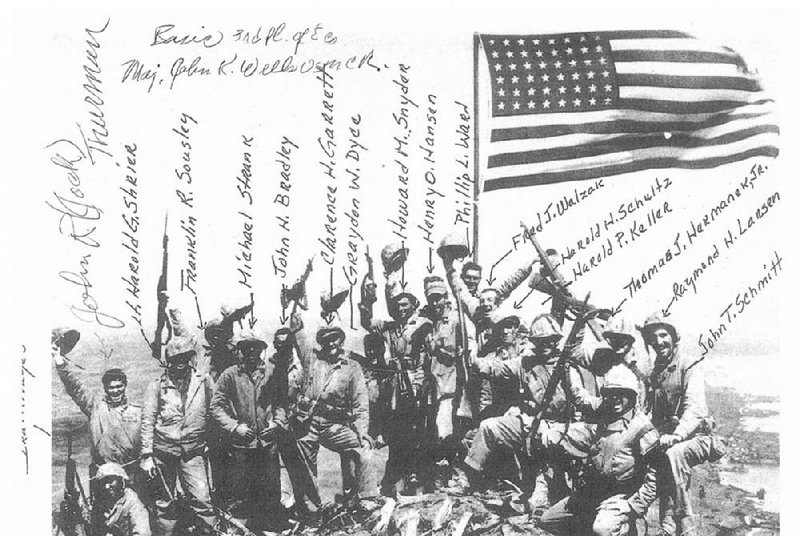The Marine Corps said in a statement Wednesday that it misidentified two men long thought to have helped raise the first of two U.S. flags atop Mount Suribachi during the bloody battle for the Japanese island of Iwo Jima in 1945.
The revelations come a little more than two months since the Marines said they had mistaken one of the individuals who helped raised the second flag, a moment captured in the iconic and Pulitzer-winning photograph taken by Associated Press photographer Joe Rosenthal.
The tale of the two flags and the men who raised them on Feb. 23, 1945, has been a part of Marine Corps lore. But the details of what happened that day have been under closer scrutiny since the publication in 2014 of an Omaha World-Herald article featuring research by two amateur historians showing that one person had been misidentified in Rosenthal's famous photograph.
In May, the Marine Corps announced that it had begun looking into Rosenthal's photograph, after inquiries from documentary filmmakers. The next month, the service said a panel -- led by a retired Marine general -- had concluded that a Marine in the second flag-raising had been misidentified. Navy Pharmacist's Mate James Bradley was actually a Marine private from Detroit named Harold Schultz.
Bradley, a Navy Cross recipient and subject of his son's book that inspired the movie Flags of Our Fathers, was instead in the lesser-known, first flag-raising.
At the conclusion of the investigation into the second flag-raising, the same panel, using some of the same photographic evidence and material from the initial inquiry, looked into the first flag-raising.
The panel's conclusion? Two Marines, Pfc. Louis C. Charlo and Pfc. James R. Michels, did not participate in the initial flag-raising, as had been previously documented. Charlo, however, participated in a four-man reconnaissance patrol that went up Suribachi, while Michels held perimeter security nearby as the first flag went up.
Charles Neimeyer, the director of the Marines' History Division, said in a phone interview that an independent researcher had first approached the Marine Corps in 2011 with evidence that Charlo and Michels were not in the initial flag-raising, and the Marine Corps decided after the investigation into Rosenthal's photograph that it would be prudent to try to update the record regarding the first raising.
The men who raised the first flag, according to the Marines' statement Wednesday, were 1st Lt. Harold G. Schrier, PhM2c John H. Bradley, Sgt. Ernest I. Thomas Jr., Sgt. Henry O. Hansen, Cpl. Charles W. Lindberg and Pvt. Philip L. Ward.
Unlike the second flag-raising, there were no pictures taken of the first flag going up, yet to the Marines fighting below, the sight of that initial flag flying was far more significant. It was the first indication they had seized the island's most significant piece of terrain and that the bloody battle might one day come to an end.
"Our history is important, and we owe it to our Marines and their families to ensure it is as accurate as possible. After we reviewed the second flag raising and found inconsistencies, we wanted to take another look at the first flag raising to make sure we had it correct," said Marine Corps Commandant Gen. Robert Neller in a statement.
In the waning months of World War II, with the huge quad-engine B-29 Superfortresses regularly bombing mainland Japan, the United States decided that Iwo Jima -- with its lone airstrip -- was an ideal spot for damaged bombers to land on their long return flights back to the Northern Mariana Islands.
The operation to seize the island, known as Operation Detachment, would last just over a month and cost the lives of more than 5,000 Marines and almost the entirety of the roughly 21,000 Japanese soldiers defending the volcanic scab of earth.
When the flags went up on Feb. 23, the Marines had been fighting for nearly four days.
As a reconnaissance patrol descended the mountain, a roughly 30-man patrol from Company E, 2nd Battalion, 28th Marine Regiment, led by 1st Lt. Harold G. Schrier, began its trek up Suribachi. Schrier had been given a small American flag from another lieutenant who had been told by 2nd Battalion's commander to make sure the patrol took the flag up the mountain, according to documents provided by the Marine Corps.
After a nearly two-hour hike, Schrier's men reached the summit and established defensive positions while a small unit looked for a place to put up the flag. Two Marines found a piece of Japanese drainage pipe, while five others affixed the flag.
Around 10:30 a.m. on Feb. 23, 1945, the first American flag went up over Iwo Jima.
Marine Capt. Louis Lowery snapped pictures of the flag shortly after it was raised, and after Schrier radioed that the summit was secure, the first flag was taken down and was sent back to the bottom of the mountain to the 2nd Battalion's commanding officer. The flag was to be turned into a war trophy and replaced on Suribachi with a more prominent one, so roughly two hours later, a resupply patrol snaked its way back to the top of the mountain, this time with a bigger flag and the photographer Rosenthal in tow.
A Section on 08/25/2016
